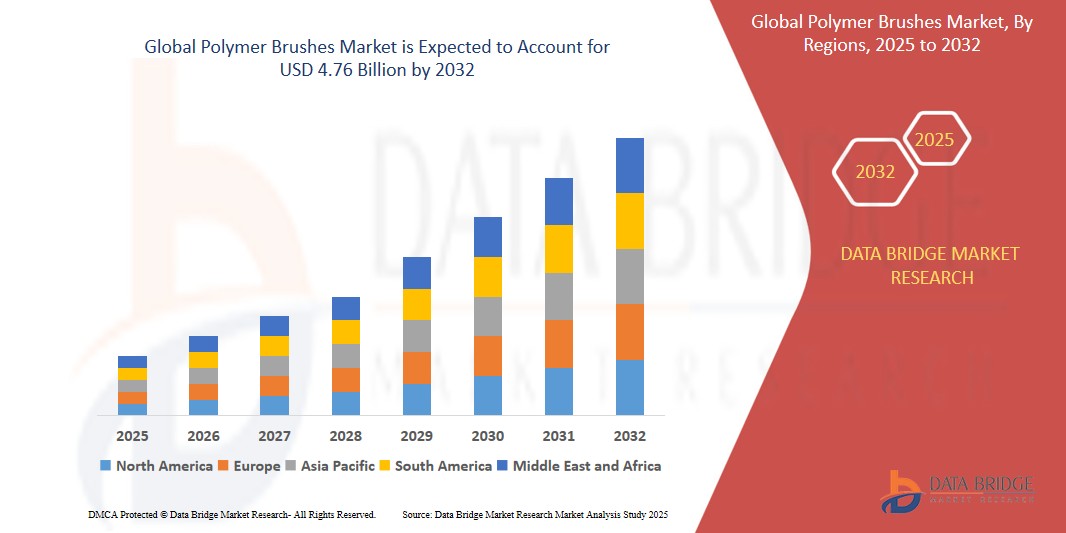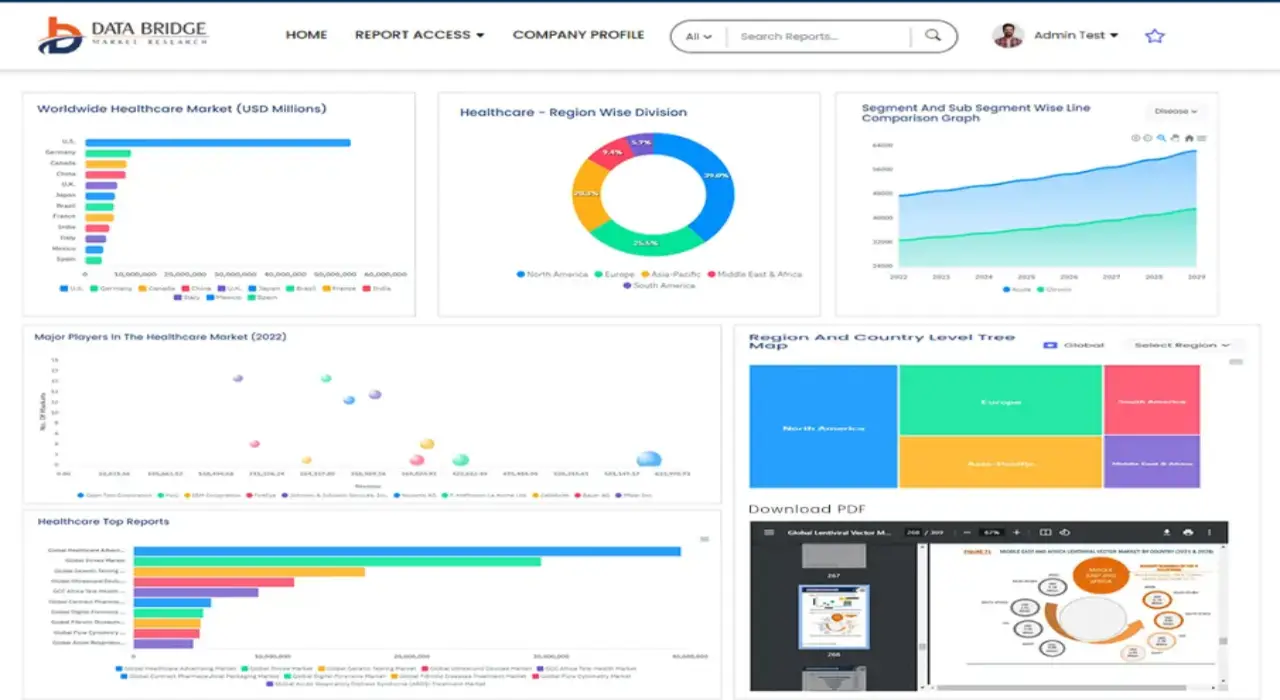Global Polymer Brushes Market
Market Size in USD Billion
CAGR :
% 
 2.47 USD
4.76 USD
2024
2032
2.47 USD
4.76 USD
2024
2032
| 2025 –2032 | |
| 2.47 USD | |
| 4.76 USD | |
|
|
|
|
Global Polymer Brushes Market Segmentation, By Type (Dry Polymer Brushes, Wet Polymer Brushes, Responsive Polymer Brushes, and Others), Application (Surface Coating, Lubrication, Anti-Fouling, Sensors, and Others), End-Use Industry (Biomedical, Electronics, Paints & Coatings, and Others), and Material (Polyethylene Glycol (PEG), Polystyrene, Polyacrylamide, and Others) – Industry Trends and Forecast to 2032
Polymer Brushes Market Size
- The global polymer brushes market size was valued at USD 2.47 billion in 2024 and is expected to reach USD 4.76 billion by 2032, growing at a CAGR of 8.40% during the forecast period.
- This growth is primarily driven by increasing demand for advanced surface modification technologies in the biomedical, electronics, and sensor industries, alongside the growing adoption of nanostructured coatings and smart materials.
Polymer Brushes Market Analysis
- Polymer brushes are polymer chains tethered at one end to a surface, forming a dense layer that alters surface chemistry and physical properties. These brushes are engineered to impart lubricity, resistance to fouling, biocompatibility, and stimuli-responsiveness.
- The market is witnessing accelerated growth due to increased use in microelectronics, biosensors, anti-bacterial coatings, and drug delivery systems, along with the rising interest in functional surfaces for high-tech applications.
- Asia-Pacific currently leads the global polymer brushes market with a market share of 38.71%, attributed to strong R&D investments, expanding electronics manufacturing base, and increasing use in healthcare and biomedical sectors.
- North America is projected to be the fastest-growing region owing to the high adoption of advanced biomedical coatings, MEMS/NEMS devices, and biocompatible sensor technologies.
- The Dry Polymer Brushes segment is expected to dominate the market, accounting for a share of 42.65%, primarily due to their enhanced mechanical strength, thermal stability, and application in wear-resistant coatings and nanoelectronics.
Report Scope and Polymer Brushes Market Segmentation
|
Attributes |
Polymer Brushes Market Insights |
|
Segments Covered |
|
|
Countries Covered |
North America
Europe
Asia-Pacific
Middle East and Africa
South America
|
|
Key Market Players |
|
|
Market Opportunities |
|
|
Value Added Data Infosets |
In addition to the insights on market scenarios such as market value, growth rate, segmentation, geographical coverage, and major players, the market reports curated by the Data Bridge Market Research also include in-depth expert analysis, pricing analysis, brand share analysis, consumer survey, demography analysis, supply chain analysis, value chain analysis, raw material/consumables overview, vendor selection criteria, PESTLE Analysis, Porter Analysis, and regulatory framework. |
Polymer Brushes Market Trends
“Integration of Polymer Brushes in Responsive and Smart Coating Applications”
- One notable trend in the global polymer brushes market is their increasing integration into responsive and smart coating technologies. This trend is gaining momentum due to the growing need for coatings that adapt to environmental stimuli such as temperature, pH, light, and humidity.
For instance, companies and research institutions are exploring polymer brush systems that can switch their wettability, adhesion, or permeability in response to external conditions, making them ideal for applications in biomedical devices, electronics, and protective coatings.
- The development of such adaptive surface coatings not only enhances the functionality of end-use products but also enables more sustainable and efficient performance.
- As the demand for smart materials rises across various industries, the use of polymer brushes in intelligent surface systems is expected to contribute significantly to market expansion.
Polymer Brushes Market Dynamics
Driver
“Rising Adoption in Biomedical and Healthcare Applications”
- The growing adoption of polymer brushes in biomedical and healthcare applications is a major driver of market growth.
- Polymer brushes provide excellent surface functionalization, enabling properties such as protein resistance, biocompatibility, and targeted drug delivery, which are critical in medical devices, implants, and diagnostics.
- With the rapid expansion of the healthcare sector and increasing investment in advanced medical technologies, there is a rising demand for surface-modified materials that enhance device performance and patient safety.
For instance, polymer brushes are being increasingly used to create anti-fouling coatings on medical implants and biosensors, reducing the risk of infection and improving operational efficiency. Companies are also developing specialized polymer brush structures tailored for use in tissue engineering and drug delivery systems.
- As the healthcare industry continues to pursue innovation and performance optimization, the demand for polymer brushes in this space is expected to remain strong and continue driving the market forward.
Restraint/Challenge
“Complexity in Large-Scale Manufacturing and Cost Efficiency”
- One of the major challenges in the polymer brushes market is the complexity involved in large-scale manufacturing and maintaining cost efficiency. Synthesizing polymer brushes often requires sophisticated techniques such as surface-initiated polymerization, which can be difficult to scale while preserving uniformity and performance.
- Additionally, the use of high-purity reagents and the need for controlled reaction environments contribute to elevated production costs.
For instance, manufacturers aiming to commercialize advanced polymer brush coatings face difficulties in achieving consistent quality across large batches, increasing the time and cost associated with scale-up.
- These technical and economic challenges limit the widespread adoption of polymer brushes, particularly in cost-sensitive sectors like packaging and consumer goods.
- Addressing these manufacturing hurdles through process innovation and cost optimization is critical to unlocking broader market potential.
Polymer Brushes Market Scope
The market is segmented on the basis of type, application, end-use industry, and material.
- By Type
On the basis of type, the Polymer Brushes Market is segmented into Dry Polymer Brushes, Wet Polymer Brushes, Responsive Polymer Brushes, and Others. The Responsive Polymer Brushes segment is anticipated to account for the largest revenue share by 2025, driven by their increasing adoption in smart coating systems, biosensors, and stimuli-responsive surfaces across biomedical and electronics applications. Their ability to alter surface properties in response to environmental stimuli such as pH, temperature, or light is propelling demand.
However, the Dry Polymer Brushes segment is expected to register the highest CAGR during the forecast period of 2025–2032, as they offer enhanced structural stability, durability, and lower solvent usage, making them particularly suitable for anti-fouling and lubrication applications in marine and industrial environments.
- By Application
On the basis of application, the Polymer Brushes Market is segmented into Surface Coating, Lubrication, Anti-Fouling, Sensors, and Others. The Surface Coating segment held the largest market share in 2025 due to extensive use in protective and functional coatings across biomedical, electronics, and industrial sectors. These coatings benefit from the improved adhesion, biocompatibility, and environmental responsiveness that polymer brushes provide.
However, the Sensors segment is projected to witness the highest CAGR during the forecast period, driven by rising demand for polymer brush-modified surfaces in chemical and biosensing platforms that require high sensitivity, selectivity, and anti-fouling properties.
- By End-Use Industry
On the basis of end-use industry, the market is categorized into Biomedical, Electronics, Paints & Coatings, and Others. The Biomedical segment is anticipated to dominate the market by 2025 owing to the growing use of polymer brushes in drug delivery systems, implants, and anti-fouling medical devices. Their superior biocompatibility, non-toxicity, and customizable surface functionality are critical for advanced healthcare applications.
The Electronics segment is expected to grow with the highest CAGR through 2032, attributed to increasing demand for nanoscale surface modification in electronic components, semiconductors, and wearable devices where polymer brushes enhance performance, insulation, and durability.
- By Material
On the basis of material, the Polymer Brushes Market is segmented into Polyethylene Glycol (PEG), Polystyrene, Polyacrylamide, and Others. The PEG segment held the largest market share in 2025, favored for its excellent biocompatibility, hydrophilicity, and protein-repellent properties, making it a popular choice in biomedical and anti-fouling applications.
Meanwhile, the Polyacrylamide segment is projected to grow at the highest CAGR during the forecast period, supported by increasing use in responsive coatings, water-based applications, and hydrogels, owing to its tunable properties and compatibility with various polymerization techniques
Global Polymer Brushes Market Regional Analysis
North America Polymer Brushes Market Insight
North America holds a substantial position in the global polymer brushes market, accounting for 34.6% of the total revenue share in 2025, driven by robust demand from high-tech sectors such as biomedical, nanotechnology, and microelectronics. The region benefits from strong R&D infrastructure, academic-industry collaborations, and government funding toward advanced material sciences.
Growing applications of polymer brushes in biosensors, anti-fouling coatings, drug delivery systems, and smart surfaces are enabling significant adoption across healthcare and semiconductor industries. Furthermore, environmental emphasis on reducing biofouling and surface contamination is pushing demand for PEG and stimuli-responsive polymer brushes.
- U.S. Polymer Brushes Market Insight
The U.S. dominates the North American polymer brushes market, propelled by significant investments in life sciences, diagnostics, and MEMS/NEMS fabrication. Institutions such as MIT, Stanford, and NIH-supported research centers are driving innovations in polymer-functionalized surfaces for tissue engineering and point-of-care devices. Demand is particularly high in biocompatible and responsive brushes used for targeted drug delivery, protein immobilization, and biosensing applications.
- Canada Polymer Brushes Market Insight
Canada’s polymer brushes market is growing steadily, supported by public-private partnerships and R&D initiatives focused on biomedical implants, lab-on-a-chip devices, and anti-microbial coatings. Leading universities like the University of Toronto and McGill are at the forefront of surface chemistry research. The market is also benefiting from the country’s push toward green materials and high-performance coatings in aerospace and defense.
Europe Polymer Brushes Market Insight
Europe represents a technologically advanced and regulation-driven market, contributing 28.3% of the global market revenue in 2025. Adoption is high across biomedical, coatings, and sensor applications due to increasing demand for environmentally friendly materials and strict REACH and RoHS compliance.
Advancements in polymer grafting techniques, 3D printing, and nanolithography are accelerating the integration of polymer brushes into wearable devices, electronic displays, and diagnostics. Furthermore, Europe's circular economy and green chemistry objectives are pushing manufacturers toward eco-friendly, solvent-free, and bio-based polymer brush materials.
- Germany Polymer Brushes Market Insight
Germany leads the European market, backed by its engineering prowess and leadership in the automotive, electronics, and life sciences sectors. Companies and research institutions are investing in surface modification technologies that enhance performance in medical coatings, sensors, and anti-corrosive applications. Polymer brushes are increasingly used in microfluidic devices, implant coatings, and energy storage systems.
- France Polymer Brushes Market Insight
France is witnessing notable expansion in polymer brush usage, driven by national strategies supporting clean energy, medical innovation, and digital transformation. Demand is particularly strong in renewable energy components, diagnostic kits, and high-resolution sensing equipment. Polymer brushes are being adopted for anti-fogging, anti-viral, and adaptive coatings, aligned with sustainable development goals and innovation funding through programs like “France 2030.”
Asia-Pacific Polymer Brushes Market Insight
The Asia-Pacific region is set to experience the fastest CAGR of 17.8% during the forecast period i.e, 2025–2032, driven by surging industrial output, increased investment in R&D, and favorable government initiatives in emerging economies like China and India.
Key sectors such as electronics, biotechnology, and surface engineering are increasingly utilizing polymer brushes for their ability to offer nanoscale control, chemical resistance, and biocompatibility. Growing interest in wearable health devices, implantable sensors, and sustainable coatings is further accelerating adoption.
- China Polymer Brushes Market Insight
China holds the largest share in the Asia-Pacific market due to massive investments in electronics manufacturing, medical device innovation, and advanced materials R&D. The use of wet and responsive polymer brushes is growing across touchscreen technologies, self-cleaning surfaces, and smart biomedical coatings. National programs under the “Made in China 2025” initiative are supporting breakthroughs in nano-coatings and biopolymer systems, stimulating strong domestic demand.
- India Polymer Brushes Market Insight
India’s polymer brushes market is witnessing rapid growth, propelled by booming sectors like diagnostics, pharmaceuticals, and flexible electronics. Government programs like “Startup India” and investments in bioengineering and nanotech incubation hubs are encouraging domestic innovation. Applications in drug eluting stents, biosensors, and nano-textured coatings are gaining traction, and the rising presence of contract manufacturing organizations (CMOs) is expected to further boost regional polymer brush consumption
Polymer Brushes Market Players
The Polymer Brushes industry is primarily led by well-established companies, including:
- Arkema S.A. (France)
- DuPont de Nemours, Inc. (U.S.)
- Sumitomo Chemical Co., Ltd. (Japan)
- Merck KGaA (Germany)
- Mitsubishi Chemical Group Corporation (Japan)
- Toyobo Co., Ltd. (Japan)
- Croda International Plc (UK)
- Evonik Industries AG (Germany)
- Lubrizol Corporation (U.S.)
- NOF Corporation (Japan)
- DIC Corporation (Japan)
- Gelest, Inc. (U.S.)
- Rieke Metals, LLC (U.S.)
- Specialty Coating Systems, Inc. (U.S.)
- Polymer Source Inc. (Canada)
Latest Developments in Global Polymer Brushes Market
- In April 2025, Arkema collaborated with the French National Centre for Scientific Research (CNRS) to develop a new generation of bio-based polymer brushes tailored for use in biomedical coatings and surface modification of implantable devices. These brushes, derived from renewable monomers, are designed to offer enhanced hydrophilicity, biocompatibility, and anti-fouling properties, meeting increasing global demand for sustainable and high-performance surface treatments in healthcare applications.
- In January 2025, DuPont Microcircuit Materials introduced a new range of functional polymer brush coatings for flexible electronics and wearable sensors. The series, launched under the brand FlexCoat-BR, enables improved signal sensitivity, moisture resistance, and flexibility, particularly in biosensor substrates and soft robotics applications. This expansion reinforces DuPont’s position in the rapidly evolving interface materials market, targeting the Asia-Pacific and North American segments.
- In October 2024, Sumitomo Chemical announced the commercialization of smart polymer brushes with thermoresponsive and pH-sensitive properties designed for use in lab-on-a-chip diagnostics and targeted drug delivery platforms. Developed through its strategic innovation center in Osaka, the product is positioned to meet growing demand in point-of-care medical devices and controlled release systems, especially across emerging economies and academic-industrial biotech clusters.
SKU-
Get online access to the report on the World's First Market Intelligence Cloud
- Interactive Data Analysis Dashboard
- Company Analysis Dashboard for high growth potential opportunities
- Research Analyst Access for customization & queries
- Competitor Analysis with Interactive dashboard
- Latest News, Updates & Trend analysis
- Harness the Power of Benchmark Analysis for Comprehensive Competitor Tracking
Global Polymer Brushes Market, Supply Chain Analysis and Ecosystem Framework
To support market growth and help clients navigate the impact of geopolitical shifts, DBMR has integrated in-depth supply chain analysis into its Global Polymer Brushes Market research reports. This addition empowers clients to respond effectively to global changes affecting their industries. The supply chain analysis section includes detailed insights such as Global Polymer Brushes Market consumption and production by country, price trend analysis, the impact of tariffs and geopolitical developments, and import and export trends by country and HSN code. It also highlights major suppliers with data on production capacity and company profiles, as well as key importers and exporters. In addition to research, DBMR offers specialized supply chain consulting services backed by over a decade of experience, providing solutions like supplier discovery, supplier risk assessment, price trend analysis, impact evaluation of inflation and trade route changes, and comprehensive market trend analysis.
Research Methodology
Data collection and base year analysis are done using data collection modules with large sample sizes. The stage includes obtaining market information or related data through various sources and strategies. It includes examining and planning all the data acquired from the past in advance. It likewise envelops the examination of information inconsistencies seen across different information sources. The market data is analysed and estimated using market statistical and coherent models. Also, market share analysis and key trend analysis are the major success factors in the market report. To know more, please request an analyst call or drop down your inquiry.
The key research methodology used by DBMR research team is data triangulation which involves data mining, analysis of the impact of data variables on the market and primary (industry expert) validation. Data models include Vendor Positioning Grid, Market Time Line Analysis, Market Overview and Guide, Company Positioning Grid, Patent Analysis, Pricing Analysis, Company Market Share Analysis, Standards of Measurement, Global versus Regional and Vendor Share Analysis. To know more about the research methodology, drop in an inquiry to speak to our industry experts.
Customization Available
Data Bridge Market Research is a leader in advanced formative research. We take pride in servicing our existing and new customers with data and analysis that match and suits their goal. The report can be customized to include price trend analysis of target brands understanding the market for additional countries (ask for the list of countries), clinical trial results data, literature review, refurbished market and product base analysis. Market analysis of target competitors can be analyzed from technology-based analysis to market portfolio strategies. We can add as many competitors that you require data about in the format and data style you are looking for. Our team of analysts can also provide you data in crude raw excel files pivot tables (Fact book) or can assist you in creating presentations from the data sets available in the report.














